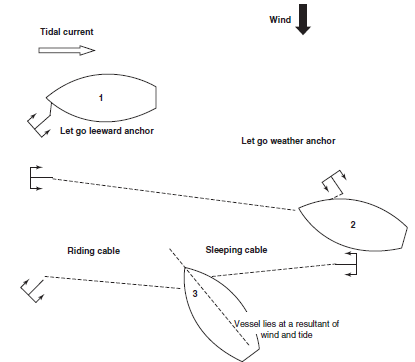Standing Moor
Standing Moor is used when the vessel is required to anchor in a tidal river or in emergency when the use of engine is limited.

Procedure:
This manoeuvre establishes the same mooring scenario as with a ‘running moor’ in that the vessel is moored between two anchors with reduced swinging room. The method of achieving a standing moor is similar, but is noticeably different by its procedure.
- Stem the tide as in position ‘1’ with both anchors walked out. Pass over the intended mooring position by about five shackles’ length of cable. Let go the LEE ANCHOR and pay out the cable as the tidal direction allows the vessel to drop astern to position ‘2’, a distance of about nine shackles, down from the position of the deployed anchor.
- With nine shackles deployed to the lee anchor, apply the windlass brake. Let go the weather anchor and engage the gear on the lee anchor already deployed. Shorten cable on this ‘riding cable’ as the vessel moves ahead while at the same time pay out on the weather anchor (now the sleeping cable) to bring the vessel to a position midway between both anchors.
- The vessel should adjust cables to show equal length (five shackles) on each cable. The riding cable will then lie with five shackles at long stay into the tidal direction, while the sleeping cable will lie with five shackles, without any weight bearing on the cable.
Note:- The vessel will adopt a resultant angle of position taking account of the tidal direction and the direction and force of the wind.


